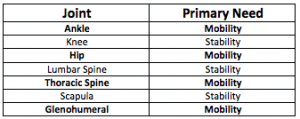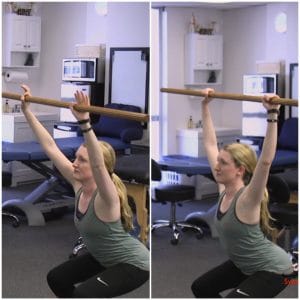Thoracic Mobility
We’re diving into the importance of thoracic mobility. The thoracic spine is a region that commonly becomes less mobile and stiffer. If we take a joint-by-joint approach, we can see that each joint in the body has a primary need based on the way it’s designed and how it functions.
Notice that each joint alternates between needing mobility and stability as we go up the body, like links in a chain. If one link is broken-down, the joints above and below are going to pick up the slack. What that means is, if a joint with a primary need for mobility becomes less mobile and stiffer, the joints above and below – which are classified as stability joints – will become less stable and more mobile to compensate for that faulty link in the chain. As you can imagine, if joints that are supposed to be more stiff and stable become mobile, that’s a recipe for injury and pain.
What happens if you don’t have thoracic mobility?
This scenario is especially prevalent in the back, neck, and shoulders. Here’s how it works:
If you lose thoracic mobility, you’ll get neck, shoulder, or lower back pain.
Once the thoracic spine loses its much-needed mobility, the lumbar spine and scapula – meant for stability – loosen up and move more to compensate for that stiff middle back.
If you take a look around, you’ll see rounded backs galore thanks to our daily habits of sitting all day, slumped over a computer, or looking down at our phones. An immobile thoracic spine is the end result of this, and shoulder, back, and neck pain are next in line. This posture-induced thoracic stiffness makes it painful and difficult to extend (sit up straight with shoulders back) and rotate.
The lumbar spine is going to react to this by become more arched (also called lordosis), and from there, your pelvis is going to anteriorly rotate, leading to lower back pain. The upper body is going to react such that you’ll have a hard time with shoulder range of motion, especially with overhead movements, since the scapula have been affected now as well. Both of these changes contribute to poor mechanics when completing an overhead squat, like what we’ve talked about this week.
Practice you Thoracic Mobility!
Try to do a squat with your arms up overhead, keeping them in line with your ears. If you find yourself leaning forward, feeling extremely tight in the shoulders and back, and your arms coming down in front of your ears, you’re probably experiencing some lack of thoracic mobility.
Take a look at the difference between a mobile thoracic spine, allowing her to keep her arms straight overhead (on the right) and a stiff thoracic spine, where her body shifts forward and she can’t fully extend to keep her arms up (on the left):
Check out our videos this week on how to attack thoracic mobility:
- Anna’s Pre-Mobility Overhead Squat:
2. Cat/Camel
3. Standing Windmill
4. Side Lying Thoracic Rotation
5. Thoracic Rotation in Quadruped
6. Reach Through in Quadruped
7. Side Plank with Reach Through
8. Anna’s Post-Mobility Overhead Squat
Conclusion
Are you dealing with body aches related to activity or exercise? We are here to help! At Symmetry, we will provide you with a comprehensive physical therapy assessment to get to the root cause of your pain. Check out our Youtube channel for more tips and easy to follow exercises videos. Making key changes to your footwear and movement strategies can help prevent a small problem from getting worse.


